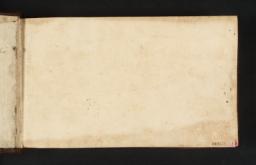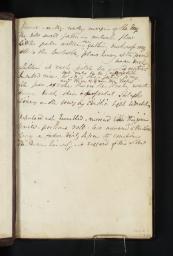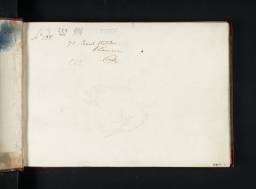Tours of the West Country and Yorkshire 1814–17

A Fawkes Family Picnic Party on the Moors near Farnley Hall
(from the Devonshire Rivers, No.3, and Wharfedale sketchbook)
From the entry
Turner had passed through Devon in 1811, during his clockwise journey round the whole of the West Country, following the coastline with occasional forays a few miles inland; the six relevant sketchbooks in the Turner Bequest are catalogued by the present author in the ‘West Country 1811’ section of this catalogue. Unusually, there are detailed eye-witness reports of Turner’s long second visit to south Devon, covered in the ‘West Country 1813’ section. He appears to have returned for the last time in 1814, although this supposition is based primarily on the interpretation of a brief passage of an undated letter, discussed below, rather than on any firmly datable sketches. The presence of Yorkshire views in two of the sketchbooks (Devon Rivers, No.2, and Devonshire Rivers, No.3 and Wharfedale) complicates matters; the Devon and Yorkshire aspects of the material are here discussed in turn. Sam Smiles, who has made the most detailed investigations of Turner in and around ...
Devonshire Rivers, No.3, and Wharfedale sketchbook 1814–16
D09789–D09855, D09857–D09888, D40878–D40884
Turner Bequest CXXXIV 1–83
D09789–D09855, D09857–D09888, D40878–D40884
Turner Bequest CXXXIV 1–83
References
Turner had passed through Devon in 1811, during his clockwise journey round the whole of the West Country, following the coastline with occasional forays a few miles inland; the six relevant sketchbooks in the Turner Bequest are catalogued by the present author in the ‘West Country 1811’ section of this catalogue. Unusually, there are detailed eye-witness reports of Turner’s long second visit to south Devon, covered in the ‘West Country 1813’ section. He appears to have returned for the last time in 1814, although this supposition is based primarily on the interpretation of a brief passage of an undated letter, discussed below, rather than on any firmly datable sketches. The presence of Yorkshire views in two of the sketchbooks (Devon Rivers, No.2, and Devonshire Rivers, No.3 and Wharfedale) complicates matters; the Devon and Yorkshire aspects of the material are here discussed in turn.
Sam Smiles, who has made the most detailed investigations of Turner in and around Plymouth, suggested that he first met the Plymouth painter Ambrose Bowden Johns (1776–1858)1 in 1811. Johns and various other local figures were to play an unusually attentive part artistically and socially during Turner’s first extended stay in south Devon in 1813, as discussed in the Introduction to that tour. The two artists subsequently maintained a friendship and correspondence.2 The postscript to an undated letter to Johns from Turner is as follows:
Give my respects to Mrs Johns. Be so good as to thank her for me “say [sic] that I got rid of my cold by catching a greater one, at Dartmouth being obliged to land from the boat half drownded [sic] with the spray of the gale compeled [sic] the boatmen to give up half way down the Dart from Totnes. but that upon my return home by a little care I have got the better of both. remembrance to all my friends
Mr Cooke having sent a Proof after me to Plymouth directed to the Mail Coach office carr. paid I will thank you to get it and let me have it for him when it may be convenient for you to send either with your Picture – the books or left until my next trip to Plymouth as he is anxious the Proof should not be lost.3
On the internal evidence of unrelated matters earlier in the letter, John Gage has suggested a date of ‘?October 1814’,4 and Smiles has agreed with this. He corroborated the date by showing that the ‘Picture’ Turner mentions can be identified through a subsequent letter to Johns from the artist Samuel Prout as a work Johns intended to send to London to be engraved; there is further circumstantial evidence in an 1815 diary entry by Joseph Farington to suggest that Turner had been in direct contact with Johns in the course of 1814.5
These points led Smiles to suggest ‘a west country tour in the late summer of 1814’.6 He has suggested a limited itinerary including a return to Gunnislake on the River Tamar; there are numerous views along the Tamar north and south of Gunnislake in the Devon Rivers, No.1 sketchbook (see under Tate D09606; Turner Bequest CXXXII 114a). However, tree studies in the Devon Rivers, No.2 sketchbook (Tate D09711–D09713; Turner Bequest CXXXIII 35a, 36 37) which, following earlier commentators, he has related7 to the painting 1815 Crossing the Brook (Tate N00497),8 do not particularly correspond, and seem from their context likely to have been made further south near Trematon Castle. The River Dart and Dartmouth sketches in the same book (see respectively under Tate D09726 and D09730; Turner Bequest CXXXIII 48, 50) include, as Smiles has noted,9 views of Sharpham, south of Totnes (Tate D09728; Turner Bequest CXXXIII 49); these are the most likely to relate to Turner’s letter and thus to 1814,10 although there is no physical evidence or pictorial representation of ‘the spray of the gale’. Smiles concluded that only the Plymouth, Hamoaze sketchbook (Tate; Turner Bequest CXXXI) can be firmly dated to 1813 because of a coastal sequence showing the Mewstone and Burgh Island, described by Turner’s companion on that trip, the Devon journalist Cyrus Redding; otherwise ‘Until such time as further evidence is forthcoming the precise date of these [Devon] sketchbooks must remain unresolved.’11
Three sketchbooks are grouped here as belonging to the 1814 tour. Given that Turner’s 1813 visit appears to have been such an intensively social event, with others often if not always on hand, there may only have been time for the Plymouth, Hamoaze drawings (numerous in themselves), some small oil sketches and, probably, the careful Tamar and Tavy views in the Vale of Heathfield sketchbook (Tate; Turner Bequest CXXXVII), as Turner must surely have made some in that area in 1813 to explain aspects of Redding’s account. The Chemistry and Apuleia sketchbook (Tate; Turner Bequest CXXXV) is likely to be from 1813 too. The author is very grateful for the opportunity to discuss the likely dating of the 1813 and 1814 West Country material with Eric Shanes, who reached a similar conclusion independently in the course of research for his forthcoming biography of Turner.12
Of the sketchbooks here assigned to 1814, identified views in Devon Rivers, No.1 (Turner Bequest CXXXII) suggest an anti-clockwise itinerary starting from east Devon, moving rapidly to the north-west coast around Barnstaple and then south via Okehampton and Launceston along the River Tamar on the Cornish border to the Gunnislake area, a few miles north of Plymouth. Devon Rivers, No.2 (Turner Bequest CXXXIII) implies a route round the southern fringes of Dartmoor from Plymouth to Tiverton (and thence presumably home to London), taking in the trip down the Dart to Dartmouth on the way. The letter to Johns about Turner’s catching cold on the river after their parting makes sense in this scenario. The larger Devonshire Rivers, No.3, and Wharfedale book includes more elaborate sketches of subjects in common with both the others. This tour would suggest Turner in more habitual mode, travelling light and without an entourage, as compared with his leisurely, sociable experience in 1813. The first and third books were titled and numbered by Turner on their covers; unfortunately those of the book Finberg called ‘Devon Rivers, No.2’ were apparently lost before 1909 along with any labels or inscriptions,13 and it is unclear whether he gave it that name on any documentary authority or simply on the assumption (correct, it would seem) that it completed the sequence of three. It is perhaps notable in view of the subsequent Rivers of Devon and Rivers of England projects (see below) that ‘Rivers’ features in the names of the sketchbooks.
If not necessarily in this exact sequence, the overall 1814 itinerary through Devon and Cornwall appears to have been as follows:
Devon Rivers, No.1: Tiverton, possibly Oakfordbridge, Chulmleigh, Barnstaple, Bideford, Appledore, Great Torrington, Hatherleigh, Okehampton, Dartmoor including Cranmere Pool, Lydford, the River Tamar near Boyton, Launceston, Polson Bridge, the Tamar again via Carthamartha and Endsleigh Cottage, Gunnislake, Tavistock, Calstock
Devon Rivers, No.2: Plymouth and the nearby Hamoaze, St German’s/Lynher River and Laira, Plympton, Ivybridge, Totnes, Dartmouth, Buckfastleigh, Buckfast Abbey, Ashburton, Exeter, Bickleigh, [Tiverton]
The main impetus for the original 1811 West Country visit had been the commission for watercolours to be engraved for the Picturesque Views on the Southern Coast of England by W.B. Cooke and others. One or two of the Devon subjects were based on 1813 sketches, as discussed in the Introduction to that tour, but none seem to have been taken from studies here assigned to 1814. The works produced for subsequent projects based on 1814 drawings are listed below (for more comprehensive listings, see the 1811 and 1813 Introductions).
Rivers of Devon, c.1814–23:14
The Rivers of England, 1823–7:16
Okehampton Castle, on the River Okement. Watercolour, c.1824 (Tate D18138; Turner Bequest CCVIII E); engraved 1825: Tate T04805–T04807.17 Sketch: Tate D09872 (Turner Bequest CXXXIV 71)
Picturesque Views in England and Wales, 1827–38:19
Although there are Yorkshire subjects in both the Devon Rivers, No.2 and Devonshire Rivers, No.3, and Wharfedale sketchbooks, it seems a matter of chance that Turner should have taken each to the north, as close analysis suggests that No.2 was probably used there later in 1814, and No.3 in 1816. For detailed discussions of these dates, see their respective Introductions. What the Yorkshire visits had in common was stays at Farnley Hall, the home of Turner’s great friend and patron Walter Fawkes (1769–1825) in the North Yorkshire dales near Leeds.25 In the case of Devon Rivers, No.2 the Yorkshire content is limited to a few pages at the beginning and end, and Turner perhaps just found it convenient to fill up a recent sketchbook. The more substantial Devonshire Rivers, No.3, and Wharfedale had only been about half filled in 1814, so there was plenty of room left in 1816, when Turner appears to have reserved its use for the more relaxed time at and around Farnley following his arduous tour of Yorkshire and Lancashire in July and August (for which see the separate section by David Hill in this catalogue).
Early in his career, Turner made watercolours to be engraved for the 1801 book History of the Original Parish of Whalley26 by the Lancashire clergyman Dr Thomas Dunham Whitaker (1759–1821).27 The main phase of the 1816 tour was in connection with Whitaker’s plan for an extensive General History of the County of York.28 120 watercolours were commissioned from Turner for the impressive total of 3,000 guineas (£3,150), but owing to Whitaker’s death only one volume, the History of Richmondshire (issued 1819–23), was completed. It included twenty prints from Turner’s watercolours,29 but the rest of the commission was cancelled. Meanwhile, Whitaker published Loidis and Elmete; or, an Attempt to Illustrate the Districts Described in those Words by Bede; and Supposed to Embrace the Lower Portions of Aredale and Wharfedale, Together with the Entire Vale of the Calder, in the County of York (Leeds and Wakefield 1816), which included four illustrations from Turner’s works, with a fifth issued subsequently:
As was customary in antiquarian publishing, the production of these plates was sponsored by the owners of the original works,37 and the Farnley subjects were also issued separately by Fawkes in his Architectural Remains Removed to Farnley by Walter Fawkes Esqre from Different Ancient Hall Houses in his Possession, 1814.38 A sixth subject has sometimes been associated with Loidis and Elmete:
Leeds. Watercolour, 1816 (Yale Center for British Art, New Haven). Lithograph 1823 (no Tate impression; British Museum, London, holds an impression).39 Sketch: Tate D09883–D09884 (Turner Bequest CXXXIV 79, 80)
In his two-volume survey of Turner’s prints, in 1908 W.G. Rawlinson initially described the lithograph as intended for the ‘2nd Edition, 1823’40 and stated that ‘a later edition of 1823 has in addition a large lithograph of the town of Leeds, also after [Turner].’41 However, when he came to catalogue the print in detail in 1913, he noted that it was said ‘to have been intended for an illustration to Whitaker’s “Leodis and Elmete.” I have, however, never seen it in a copy of that work’.42 For further discussion see the entry for D09883.
Lastly, two 1816 Yorkshire subjects from the Devonshire Rivers, No.3, and Wharfedale book were developed for the Picturesque Views in England and Wales:
For Johns see John Gage, Collected Correspondence of J.M.W. Turner with an Early Diary and a Memoir by George Jones, Oxford 1980, pp.261–2; and Smiles 1987, pp.11–13.
Smiles 1987, p.12; see also Smiles 2006, p.23; and Kennedy 2001, p.76, mentioning a ‘third visit’ to Devon in 1814 without further detail or discussion.
Martin Butlin and Evelyn Joll, The Paintings of J.M.W. Turner, revised ed., New Haven and London 1984, pp.93–4 no.130, pl.123 (colour).
Emails of 6 and 7 December 2011 to the author, confirmed in broad terms in the course of Shanes’s Turner Society Pantzer Memorial Lecture ‘Young Mr Turner: Some New Discoveries’, delivered in London on 23 April 2014.
W[illiam] G[eorge] Rawlinson, The Engraved Work of J.M.W. Turner, R.A., vol.I, London 1908, pp.xci, 74–6 nos.137–140.
Andrew Wilton, J.M.W. Turner: His Life and Work, Fribourg 1979, p.350 no.442, reproduced; Rawlinson I 1908, pp.xci, 75–6 no.139.
Wilton 1979, p.393 no.800, reproduced; Rawlinson I 1908, pp.xciv, 127 no.224; see also Rawlinson I 1908, p.xcvi, II 1913, p.220 no.316 (‘small replica’ in The Literary Souvenir, 1827).
For a concise summary of Fawkes and Farnley see James Hamilton, ‘Fawkes, Walter Ramsden (1769–1825)’ in Evelyn Joll, Martin Butlin and Luke Herrmann (eds.), The Oxford Companion to J.M.W. Turner, Oxford 2001, pp.103–5.
See Stanley Warburton, Turner and Dr. Whitaker, exhibition catalogue, Towneley Hall Art Gallery & Museums, Burnley 1982, and Luke Herrmann, ‘Whitaker, Dr Thomas Dunham (1759–1821)’ in Evelyn Joll, Martin Butlin and Herrmann (eds.), The Oxford Companion to J.M.W. Turner, Oxford 2001, pp.380–1.
See Warburton 1982, David Hill, In Turner’s Footsteps: Through the Hills and Dales of Northern England, London 1984, and Herrmann 2001.
Wilton 1979, p.324 no.219, reproduced, incorrectly noted as based on Tate D00985 (Turner Bequest XXXIV 76); Rawlinson I 1908, pp.xc, 41 no.83.
For Harewood, see David Hill, Turner in the North: A Tour through Derbyshire, Yorkshire, Durham, Northumberland, the Scottish Borders, the Lake District, Lancashire and Lincolnshire in the Year 1797, New Haven and London 1996, pp.152–61.
See William Upcott, A Bibliographical Account of the Principal Works Relating to English Topography, London 1818, vol.III, pp.1387, 1390, where the plate is ‘announced as nearly ready for publication’.
How to cite
Matthew Imms, ‘Tours of the West Country and Yorkshire 1814–17’, July 2014, in David Blayney Brown (ed.), J.M.W. Turner: Sketchbooks, Drawings and Watercolours, Tate Research Publication, September 2014, https://www



